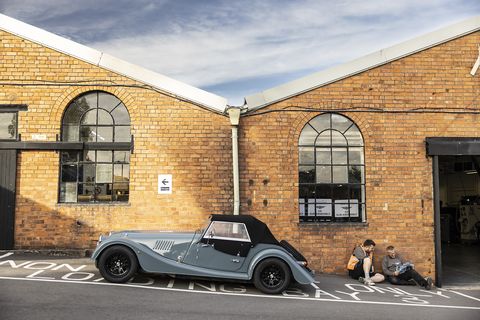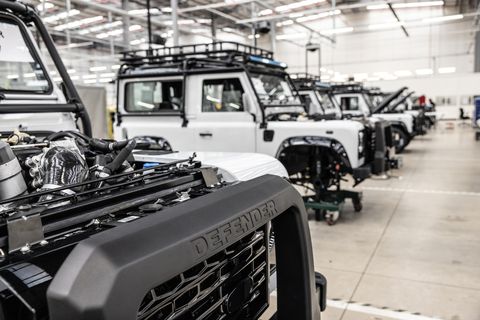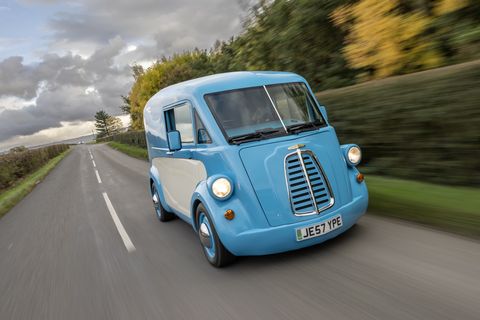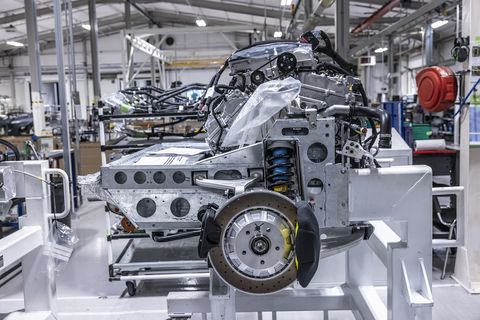Britain’s Auto Industry Is Down but Not Out

From the January 2023 issue of Car and Driver.
Curse globalization all you like, but it’s a safe bet that what remains of England’s automobile industry wouldn’t be here today without investments from around the world. Over the course of a week driving around Britain, we visited several enterprises that are not so much surviving as thriving, all thanks to foreign connections willing to open their wallets.
There’ll Always Be an England
Our journey begins with a trip to West Sussex, where Rolls-Royce launched the Spectre, the 116-year-old company’s first electric production car, a plus-size coupe of undeniable presence. Erected with parent BMW’s money, its showpiece Goodwood factory is now configured to build internal-combustion and electric cars on the same line. The airy, low-lying corporate home on lush country grounds is a most British of settings and can only help as the company attempts to upsell returning customers and visiting prospects bespoke hides, paint schemes, and more from its steamship-size list of pricey custom options. That body shells, engines (for now), and many other critical parts come from Germany for assembly in England isn’t something they talk much about here, where Britishness is an essential part of the appeal.
Mini’s modern assembly line.
Charlie Magee|Car and Driver
The following morning, we head to the Mini plant in Oxford, built out with the unstinting assistance of the same German benefactor. Tours commence in a small museum that occupies part of the factory that turned out the first Morris Oxford, which in the 1920s made William Morris’s firm Britain’s biggest car producer. It merged with Austin in the 1950s to form BMC, then combined with other ailing firms in the 1960s to form British Leyland, and in ensuing decades found itself involved with a host of similarly troubled successor entities that had different names. One of the few things to survive it all was the Mini brand, the only marque BMW kept when it discarded the rest of what had become the Rover Group.
Two decades after its relaunch for 2002 as a stand-alone brand, Mini is here building zippy electric models on the same line as gas and diesel cars, thanks to extensive use of modern robotics. The plant is notably quiet in operation, and the mood appears upbeat.
This is in spite of Mini’s announced plans to shift production of EVs to China, a potentially ominous development for a brand that plans to be all electric. At present, 40,000 electric Minis leave Plant Oxford each year. “Mini Plant Oxford is the heart of the brand,” says Stefanie Wurst, global head of Mini. “Our commitment to production in the United Kingdom has not lost any strength whatsoever.” A new Chinese plant is being built to grow share there, where, she explains, imported Minis currently cost as much as locally produced BMW 3-series. While a second production site in Leipzig will build one Mini model, the U.K. plant will supply three models. “In other words,” Wurst says, “no other plant will be building as many models as Oxford.”

Charlie Magee|Car and Driver
We again witness foreign inroads into the British market when we arrive at Malvern Link in Worcestershire to visit the 113-year-old Morgan Motor Company. The charmingly dinky factory buildings date to the early 20th century, with little to give away all that is new within, thanks once again to investment from abroad.
Yet change has come to the cars and the processes used to build them. Expanding the list of Anglophile saviors from afar, Italian businessman Andrea Bonomi and his family’s private equity firm, Investindustrial, bought a controlling interest in the business in 2019 from the Morgan family (who retain a minority holding and role as “brand stewards”), giving the hidebound company a new lease on life.
Its heavily revised “volume” Plus Four roadster, powered by a turbocharged 2.0-liter four from—guess who—BMW, is again slated to be offered for sale in America in 2023, bolstered by a new world of contemporary features [read our first drive of the Morgan Plus Four]. The car’s charismatic good looks still trace to the 1930s, but its platform and suspension at last are now modern, ridding the Morgan of its infernal and near-eternal nod to antiquity.
Just as impressive to drive and also headed to the States once again is a new Morgan three-wheeler. Not the stillborn electric concept scuttled in 2018, the new Super 3 replaces its predecessor’s spindly ladder frame and wood-frame body with a full aluminum chassis. Meanwhile, a turbocharged Ford 118-hp 1.5-liter inline-three steps in for the Harley-inspired V-twin that had become one of Morgan’s worst-ever warranty nightmares. The pint-size three-pot makes the slightly less adorable-looking Super 3 faster and, more important, far more bearable on the noise, vibration, and harshness front.
Still, there’s nothing cushy about the experience of driving the new car. Windscreens are minimalist afterthoughts. With a nonexistent top, the wind, rain, and bugs are yours to enjoy. But who cares? A wider front track improves handling, and the Mazda Miata–sourced five-speed gearbox remains impressive. They help make the Super 3—all 1500 pounds of it—an exhilarating small-bore blaster that we found completely nuts and didn’t want to return.

Charlie Magee|Car and Driver
Next stop is Jaguar Land Rover’s Classic Works in Coventry, once a bustling car-building city—England’s Detroit, if you will. Things have tapered off if not petered out entirely in Coventry, but heritage is one of Britain’s chief exports these days. In fact, the country increasingly resembles a theme park whose theme is the past. The monarchy is one example, but nothing in the world of consumer goods has more heritage appeal than classic cars.
Given the rising values of older Jaguar and Land Rover models, it only made sense for JLR to cater to the buoyant classic-car market. So, with a little help from Indian parent Tata, it opened the Classic Works enterprise in 2017. Today, in a ginormous workshop adjacent to a large showroom filled with sparkling machines from its past, skilled technicians and craftsmen restore old cars and service others, even recreating classic models such as Jaguar’s D-type, XKSS, and Lightweight E-type in continuation series. It started with the Land Rover Reborn program, which has cranked out more than 50 refurbished original-formula Landies from the late ’40s and ’50s. More profitable still are the 150 70th Anniversary Edition Defender Works V8s it has sold, along with 25 Works V8 Trophy tributes and another 25 Works V8 Trophy Twos, all with six-figure price tags. The newest program has started delivering reborn Range Rovers, the early ones purists are falling for in a big way.
Mike Bishop oversees the Range Rover Reborn program. “The vehicles sell themselves, effectively,” he says. “You’re just here to help enjoy the journey. You’re not really selling them an everyday car, are you? You’re selling them that dream.”
Down by the Cotswolds, in tiny Hinton-on-the-Green, Morris Commercial’s controlling shareholder, Qu Li, has a dream of her own. A Chinese mechanical engineer who’s spent 30 years in the U.K., for 2023 she hopes to put into limited production an electric van inspired by the beloved postwar Morris J-type van, once a ubiquitous postal and delivery vehicle highly regarded for its excellent space-to-footprint ratio and jolly visage. Looking possibly better than ever, the updated van Morris Commercial hopes to build will feature a body made of recycled carbon fiber.
Though it has but two prototypes to show for itself so far, the story of Morris Commercial already sounds like fodder for a gripping tome. Li and her China Ventures consultancy worked closely with the “Phoenix Four,” the briefly celebrated quartet of British businessmen who rescued MG Rover from extinction in 2000 after BMW pulled the plug, only to put the enterprise into the ditch in 2009 (while still managing to walk away with large piles of cash).

Charlie Magee|Car and Driver
From the wreckage of MG Rover, Li bought out of bankruptcy van maker LDV, which was formed in 1993 by the merger of two ailing firms, Britain’s Leyland and Holland’s DAF. Li quickly sold the rights to LDV’s vehicles, using the proceeds of the sale to develop Morris Commercial. Shrewdly, she identified the old J-type—which was introduced alongside the Morris Minor in 1948—as her ticket to ride.
We drove a running blue and white prototype of the electric Morris van. Bodied in aluminum, it is more of a proof of concept, where a pink and white model with the recycled-carbon-fiber body is closer to the hoped-for final product and spec. Though neither really represents what the finished van might actually be like, the blue truck was perfectly pleasant and, with its skateboard chassis, usefully large inside. We can confirm that passersby go mad for its retro good looks. It’s that cute.
From hopeful startup to ambitious old hands: Our last stop is at Hethel, Norfolk, where the fruits of Chinese juggernaut Geely’s multibillion-dollar investment in Lotus Cars are everywhere to see. From the 1973-hp Evija EV to the company’s excellent new volume machine, the Emira, and the newly outfitted factory that will build it, Lotus’s current situation underscores what a lot of good money can do.

Lotus plant in Hethel.
Charlie Magee|Car and Driver
As Lotus approaches its 75th anniversary, the roller-coaster ride it has been on for its entire existence has entered a new phase. With its new foreign owners, Lotus plans to increase volume exponentially—not just here at its ancestral and spiritual home base, but in China, where its first SUV, the Eletre, is already in production.
But while the Eletre, a two-motor electric SUV claimed to be the fastest of its species in the world, is expected to help Lotus achieve an unheard-of annual sales volume of 100,000 before decade’s end, the 5000 Emiras it hopes to build here annually mark a different roll of the dice. The last purely internal-combustion car the company says it will ever build, the Emira caps a long line of lightweight sports cars that prioritize roadholding and an intimate connection between driver and machine. Even though it is heavier than all Lotuses that have preceded it, the Emira is still meant to follow that path.
It also lays the groundwork for a new generation of Lotus sports cars, whose content and construction will be effected here in the Norfolk countryside. They will all be electrified, with the weight penalty that implies, as truly lightweight electric cars are a ways off, awaiting as yet undiscovered battery technologies.

Charlie Magee|Car and Driver
Lotus’s prospects have improved immeasurably thanks to the largesse of Geely, an operation that has demonstrated a surprisingly delicate touch with its foreign holdings, as exemplified by its purchase of Volvo. (In October 2022, Geely acquired a minority stake in Aston Martin.) The Chinese firm seems less vulnerable than Western companies to the impatience of jittery shareholders and the short-sighted broader market. It is therefore seemingly able to operate with a longer timeframe in mind.
Which is a good thing. For as any Briton could tell you, the creation of a heritage worth remembering takes time. And money. Wherever it comes from.
This content is imported from OpenWeb. You may be able to find the same content in another format, or you may be able to find more information, at their web site.



